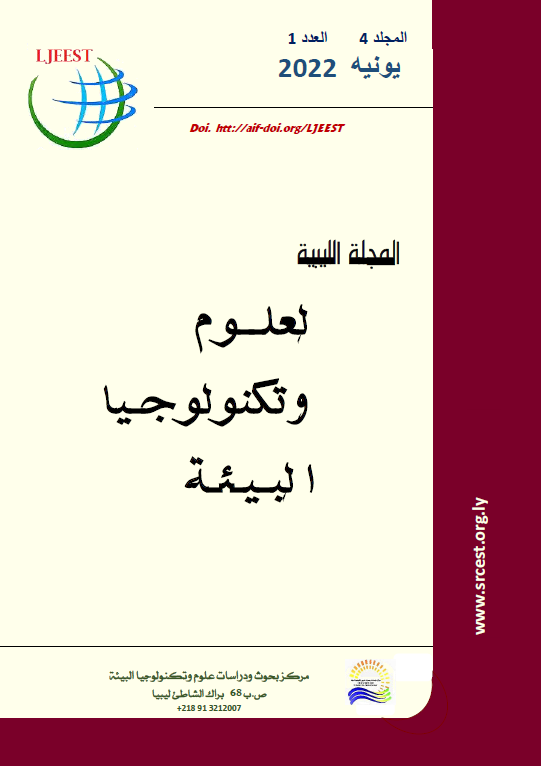الري بالمياه الجوفية النوبية الضحلة والعميقة على خصائص التربة وإنتاج المحاصيل في واحة الكفرة ، ليبيا
DOI:
https://doi.org/10.63359/2zk2dc37الكلمات المفتاحية:
انتاج المحصول، المياه الجوفية، الري، المزارع الخاصة، خواص التربة، المزارع العامةالملخص
تقع واحة الكفرة في أقصى جنوب شرق ليبيا، في عمق الصحراء الكبرى. وهي تغطي مساحة تقدر بحوالي 3630 كيلومتر مربع. الأمطار في هذه المنطقة الصحراوية والجافة تعتبر نادرة الحدوث، والزراعة فيها تعتمد بشكل أساسي على المياه الجوفية (الخزان النوبي). معظم المزارع في منطقة الكفرة وما حولها تعتبر مزارع خاصة تستخدم طريقة الغمر في عمليات الري من آبار ضحلة (بعمق 18-55 متر) من الخزان الجوفي العلوي. أما مشروع الكفرة الزراعي (الحكومي) فيتكون من 100 دائرة (قطر كل منها حوالي 1 كيلومتر وتغطي مساحة 78.5 هكتار) ويعتمد على آبار عميقة (بعمق 220-352 متر) من الخزان الجوفي العميق. هذه الدراسة هدفت إلى تقييم جودة مياه الري في كلا الخزانين الجوفيين العلوي والعميق في منطقة الكفرة، وتقييم تأثيرها على خواص التربة وإنتاجية المحاصيل (الصفصفة والبطاطس). طبقا لتقسيم مياه الري لمنظمة الفاو (FAO)، فقد صنفت مواصفات المياه المنتجة من 97% من الآبار العميقة التي تمت دراستها بأنها ملائمة لعمليات الري، وفقط 3% وقعت تحت فئة التحفظ البسيط إلى المتوسط في الاستعمال للري (E.C.> 0.7 dS/m). وصنفت مياه 78% من الآبار الضحلة حسب تصنيف الفاو في الفئة ذات التحفظ الشديد جدا للاستعمال في الري نتيجة ارتفاع ملوحتها (E.C.> 3 dS/m)، وصنفت 22% من الآبار الضحلة تحت فئة التحفظ البسيط إلى المتوسط في الاستعمال. درجة جودة المياه المستعملة في الري في واحة الكفرة انعكست بشكل مباشر على خصائص التربة وإنتاجية المحاصيل المزروعة. ترب المزارع الحكومية بمشروع الكفرة كانت لها قيم طبيعية لكل من pH، E.C.، و ESP%، في حين صنفت ترب 10% من المزارع الخاصة كترب ملحية غير قلوية، و 70% كترب ملحية قلوية. تركم الأملاح في منطقة نمو الجذور بالتربة يؤثر بشكل كبير على إنتاجية المحاصيل المزروعة، وبشكل أكثر وضوحا في ترب المزارع الخاصة لاعتمادها على مياه الآبار الضحلة مرتفعة الملوحة، وأيضا نظرا لاستخدام طرق ري غير مناسبة. هذه الدراسة سلطت الضوء على ضرورة وأهمية اتخاذ إجراءات عاجلة جدا من أجل نقل قطاع الزراعة في واحة الكفرة للاعتماد على الخزان النوبي الجوفي العميق وعلى تغيير أساليب الزراعة وطرق الري وعلى اختيار المحاصيل الأكثر مناسبة للمناخ الصحراوي الجاف وللترب الملحية القلوية.
المراجع
Abedi-Koupai, J., Mostafazadeh-Fard, B., Afyuni, M. and Bagheri, M.R. (2006). Effect of treated wastewater on soil chemical and physical properties in an arid region. Plant Soil and Environment, 52, 335-344
Al-Suhaibani, N.A. (2010). Estimation yield and quality of alfalfa and clover for mixture cropping pattern at different seeding rates. American-Eurasian of Journal Agriculture and Environmental Science, 8, 189-196.
APHA (1992). Standard methods for the examination of water and wastewater (16th ed). APHA, AWWA, and WPCF.
Ardahanlioglu, O., Oztasw, T., Evren, S., Yilmaz, H. and Yildirim, Z.N. (2003). Spatial variability of exchangeable sodium, electrical conductivity, soil pH, and boron content in salt- and sodium-affected areas of the Igdir plain (Turkey). Journal of Arid Environments, 54, 495-503.
Ayers, R. S., and Westcot, D. W. (1985). Water quality for agriculture. Rome: Food and Agriculture Organisation Irrigation and Drainage Paper.
Barber, S.A. (1995). Soil nutrient bioavailability; A mechanistic approach, Second Edition. New York: John Wiley & Sons.
Bhardwaj, A.K., Mandal, U.K., Bar-Tal, A., Gilboa, A. and Levy, G.J. (2008). Replacing saline-sodic irrigation water with treated wastewater: effects on saturated hydraulic conductivity. Irrigation Science, 26, 139-146.
Bravo-Garza, M.R. and Bryan, R.B. (2005). Soil properties along cultivation and fallow time sequences on vertisols in Northeastern Mexico. Soil Science Society of America Journal, 69, 473-481.
Cardoso, E. N., Vasconcellos, R. F., Bini, D., Miyauchi, M.Y.H., Santos, C. A., Alves, P.R.L., Monteiro de Paula, A., Nakatani, A. S., Pereira, J. M. and Nogueira, M. A. (2013). Soil health: looking for suitable indicators. What should be considered to assess the effects of use and management on soil health, Scientia Agricola, 70, 274-289.
Chapman, H. D., and Pratt, P. F. (1961). Methods of analysis for soils, plants, and waters. Riverside: University of California, Division of Agricultural Sciences.
Dregne, H. E. (1986). Physics of desertification. In: El-Baz, F. and Hassan, M.H.A. ed. Desertification of arid lands. Dordrecht: Springer Netherlands., pp 4-34.
Ellwood, M. S., and Hickes, J. R. (1991). Kufra agriculture project, water and soil survey. York: Yara Phosyn Ltd.
FAO, (2002). Crops and drops, making the best use of water for agriculture, publishing management service. Information division FAO. The land and water development division, FAO, Rome, Italy .//ftp.fao.org/agl/aglw/docs/cropsdrops_e.pdf
Flowers, T. J and Flowers, S. A (2005). Why does salinity pose such a difficult problem for plant breeders? Agricultural Water Management, 78, 15-24.
Gregorich, E. G., & Carter, M. R. (2007). Soil sampling and methods of analysis. Boca Ratan, FL: CRC Press.
Gros, R., Poulenard, J., Monrozier, L. J. and Faivre, P. (2006). Soil Physico-chemical changes following application of municipal solid waste leachates to grasslands. Water, Air and Soil Pollution, 169, 81- 100.
Henry, J. L., and Hogg, T. J. (2003). Irrigation sustainability–Saskatchewan activity. Outlook: Canada- Saskatchewan Irrigation Diversification Centre.
Khresat, S. A. and Taimeh, A. Y. (1998). Properties and characterisation of vertisols developed on limestone in a semiarid environment. Journal of Arid Environments, 40, 235-244.
Kinniburgh, D. G., and Smedley, P. L. eds (2001). Arsenic contamination of groundwater in Bangladesh, Volume 1 Summary W.C./00/19 Keyworth: British Geological Survey.
Lawgali, F. F. (2008). Forecasting water demand for agricultural, industrial, and domestic use in Libya. International Review of Business Research, 4, 231 – 248.
Laytimi, A. ed. (2002). Market and Trade Policies for Mediterranean Agriculture: The case of fruit/vegetable and olive oil, MEDFROL PROJECT, Agricultural Situation Report – Libya. Meknès: Department of Animal Production, Ecole Nationale d’Agriculture.
Loncnar, M., Zupancic, M., Bukovec, P. and Justin, M. Z. (2010). Fate of saline ions in a planted landfill site with leachate recirculation. Waste Management, 30, 110-118.
Loreto, F., Centritto, M. and Chartzoulakis, K. (2003). Photosynthetic limitations in olive cultivars with different sensitivity to salt stress. Plant, Cell and Environment, 26, 595-601.
Mostafazadeh-Fard, B., Heidarpour, M., Aghakhani, A. and Feizi, M. (2007). Effects of irrigation water salinity and leaching on soil chemical properties in an Arid Region. International Journal of Agriculture and Biology, 9, 466-469.
Munns, R. (2002). Comparative physiology of salt and water stress. Plant, Cell and Environment, 25, 239-250.
Munns, R. (2005). Genes and salt tolerance: bringing them together. New Phytologist, 167, 645-663.
National Engineering Handbook, Part 652 (1997). Natural Resources Conservation Service. Michigan United States Department of Agriculture, pp. 1-191.
Osman, A.E., Ibrahim, M. H. and Jones, M. A. eds. (1990). The role of legumes in the farming systems of the Mediterranean areas: Proceedings of a workshop on the role of legumes in the farming systems of the Mediterranean area. Berlin: Springer Science and Business Media. pp: 3-29.
Paliwal, K. V. and Gandhi, A. P. (1976). Effect of salinity, SAR, Ca: Mg ratio in irrigation water, and soil texture on the predictability of exchangeable sodium percentage. Soil Science, 122, 85-90.
Paranychianakis, N. V. and Chartzoulakis, K. S. (2005). Irrigation of Mediterranean crops with saline water, from physiology to management practices. Agriculture, Ecosystems and Environment, 106, 171-187.
Patel, R. M., Prasher, S. O., Donnelly, D. and Bonnell, R. B. (2001). Effect of initial soil salinity and sub irrigation water salinity on potato tuber yield and size. Agricultural Water Management, 46, 231-239.
Qiyan, F. and Baoping, H. (2002). Hydrogeochemical simulation of water-rock interaction under waterflood recovery in Renqiu Oil field, Hebei Province, China. Chinese Journal of Geochemistry, 21, 156-162.
Ragab, R. (2010). Preface: Salinity management in agriculture. In: Gheyi, H. R., Dias, N. D. and de Lacerda, C. F. eds. Salinity Management in Agriculture: Basic and Applied Studies. Fortaleza, Brazil. National Institute of Science and Technology in Salinity. pp. 1- 3.
Richards, L.A. (1954). United States salinity laboratory staff, diagnosis, and improvement of saline and alkali Soils. In: Allison, L. E., Brown, J. W., Hayward, H. E., Richards, L. A., Bernstein, L., Fireman, M., Pearson, G. A., Wilcox, L. V., Bower, C. A., Hatcher, J. T. And Reeve, R. C., eds. Soil and Water Conservation Research Branch, Agricultural Research Service. Washington, United States Department of Agriculture.
Robbins, C. W., and Carter, D. L. (1983). Selectivity coefficients for calcium- magnesium-sodium-potassium-exchange in eight soils. Irrigation Sciences, 4, 95-102.
Saaed, Manam W B (2018). Assessment of degradation and prospects of rehabilitation of the arid rangelands in the Tanqua Karoo region, South Africa, Tankwa Karoo National Park as a case study, Ph.D. thesis, Department of Conservation Ecology and Entomology, Faculty of AgriSciences, Stellenbosch University.
Shrivastava, P. and Kumar, R. (2015). Soil salinity: A serious environmental issue and plant growth promoting bacteria as one of the tools for its alleviation. Saudi Journal of Biological Sciences, 22, 123-131.
Subba Rao, M.V. and Muralikrishna, G. (2002). Evaluation of the antioxidant properties of free and bound phenolic acids from native and malted finger millet (Ragi, Eleusine coracana Indaf-15). Journal of Agricultural and Food Chemistry, 50, 889- 892.
Tanwir, F., Saboor, A. and Nawaz, N. (2003). Soil salinity and the livelihood strategies of small farmers: A case study in Faisalabad district, Punjab, Pakistan. International Journal of Agriculture and Biology, 5, 440-441.
Tarchitzky, J., Lerner, O., Shani, U., Arye, G., Lowengart-Aycicegi, A., Brener, A. and Chen, Y. (2007). Water distribution pattern in treated wastewater irrigated soils: hydrophobicity effect. European Journal of Soil Science, 58, 573-588.
Wallach, R., Ben-Arie, O. and Graber, E.R. (2005). Soil water repellency induced by long term irrigation with treated sewage effluent. Journal of Environmental Quality, 34, 1910- 1920.
Wang, Z., Chang, A.C., Wu, L., and Crowley, D. (2003). Assessing the soil quality of long term reclaimed wastewater-irrigated cropland. Geoderma, 114, 261-278.
Yousef, A. F. (1985). Soil and water resources of Taworgha Oasis. King Saud University Sciences. 7, 517-527.
Zheng, Y., Stute M., Van Geen A., Gavrieli I., Dhar, R., Simpson, H. J., Schlosser P. and Ahmed, K. M. (2004). Redox control of arsenic mobilisation in Bangladesh groundwater. Applied Geochemistry, 19, 201-214.
Zhu, J.K. (2001). Plant salt tolerance. Trends in Plant Science, 6, 66-71.
منشور
إصدار
القسم
الرخصة
الحقوق الفكرية (c) 2025 المجلة الليبية لعلوم وتكنولوجيا البيئة

هذا العمل مرخص بموجب Creative Commons Attribution-NonCommercial 4.0 International License.














